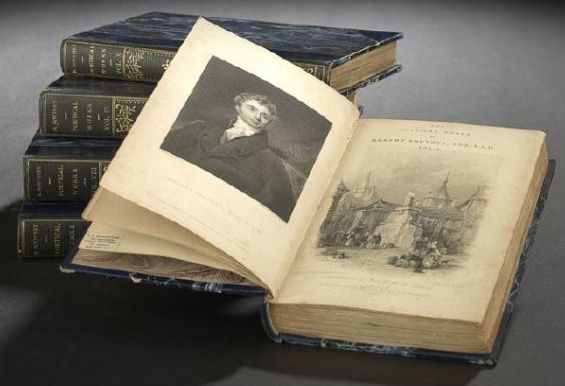 Robert Rivière (1808 to 1882), born the son of a drawing master and the brother of artists, apprenticed as a bookseller and binder in London. In 1829, he established himself as a seller and binder in Bath, and in 1840, he removed to London and focused solely on bookbinding. His skill was recognized by both nobility and royalty, receiving commissions from Queen Victoria, exhibiting at the Crystal Palace Exhibition, and binding a special edition of the Crystal Palace Exhibition catalog presented to royals from throughout Europe. He was also chosen to rebind the Domesday Book.
Robert Rivière (1808 to 1882), born the son of a drawing master and the brother of artists, apprenticed as a bookseller and binder in London. In 1829, he established himself as a seller and binder in Bath, and in 1840, he removed to London and focused solely on bookbinding. His skill was recognized by both nobility and royalty, receiving commissions from Queen Victoria, exhibiting at the Crystal Palace Exhibition, and binding a special edition of the Crystal Palace Exhibition catalog presented to royals from throughout Europe. He was also chosen to rebind the Domesday Book.
Rivière and his wife, Eliza, had two daughters, and in 1880, he went into partnership with his grandson, Percival Calkin, and changed the firm’s name to Robert Rivière and Son. The firm continued in operation until 1939 when it was purchased by noted bookseller and binder George Bayntun (1873 to 1940). After struggling through World War II, during which much of the staff AND the binder itself served in the war effort, the Bayntun-Rivière firm was appointed, in 1950, Bookseller to Her Majesty. The firm is still in operation today, and still produces exceptional bindings entirely by hand.
Books bound (or rebound) by any incarnation of the Rivière bindery are highly sought after, and can command significant prices at auction. They are typically of colorful morocco (goatskin) and elaborately gilt-stamped, sometimes including pictorial designs on the boards. One of the most popular types of Rivière binding is referred to as a Cosway binding because they include inset miniature portraits on ivory inspired by the noted British miniaturist Richard Cosway (1742 to 1821). John H. Stonehouse (1864 to 1937) developed this binding at the bookselling firm of Henry Sotheran and Company. He selected Rivière to create the bindings and Mrs. C.B. Currie to execute the miniatures, beginning in the early 20th century.
Most Rivière bindings are stamped, and based on the stamp, they can usually be dated as follows:
“Bound by R. Rivière, Bath” refers to 1829 to 1832
“Bound by R. Rivière” refers to 1832 to 1840
“Bound by Rivière” refers to 1840 to circa 1860
“Bound by Rivière & Son” refers to 1880 to circa 1939
“Bound by Bayntun & Rivière, Bath, England” refers to 1939 and later





